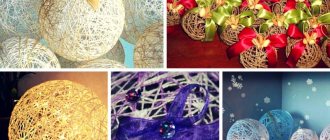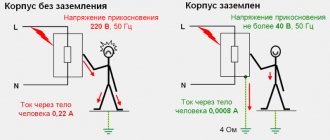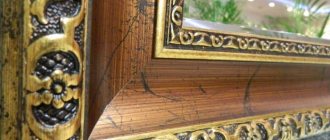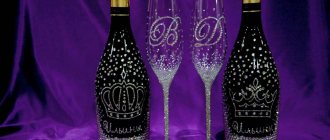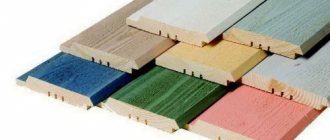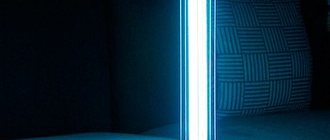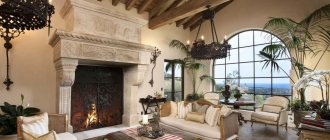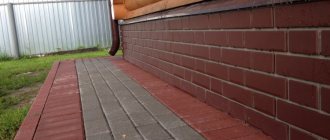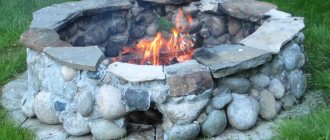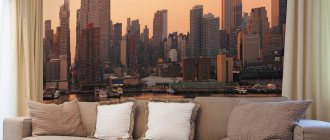How to make your own mat
Many people think that a mat is very difficult to create with your own hands, but no - of all the floor coverings, it is the easiest to weave.
If you know the manufacturing technology well, you can quickly weave a mat yourself. You can get acquainted with the weaving technique in a few hours. Whatever material you use, the weaving technique always remains the same. You can purchase such material on the market, or you can prepare it yourself.
However, the preparation of the material is carried out in different ways. For example, straw or sponge should be wrapped in a very wet rag.
Immersed in water:
- hop,
- birch bark
- bast.
After 3 hours, remove the material, wait until the water has completely drained, and begin work. The fibers should always be kept in a damp cloth.
To create a colored mat, the prepared material needs to be dyed. Aniline dyes are considered the best coating for mats. Before painting, the paint must be dissolved.
Homemade cattail mat
After the material is in the solution, it is brought to a boil, set to low heat and left for one hour. Next, the paint needs to be dissolved in a small amount of heated water. After the paint has dissolved, add table salt and a small amount of hot water to the solution.
The raw material is dipped into the paint. Maintaining low heat, the material is kept in paint for one hour. During such an operation, it is necessary to ensure the uniformity of the coating. To prevent stains from appearing, the material must be turned over periodically. Narrow strips are laid out in parallel order on a long board. A certain distance is maintained between them. Each row is intertwined with a transverse strip, observing the desired sequence. First, the movement is made from right to left, then from left to right. Such a tape can have nine stripes. When weaving rows, they constantly alternate direction: first from the right, then from the left, and so on. The new row is not woven to the end. They stop in the middle. The next row starts on the side with the most stripes. You can weave a fabric from absolutely any number of strips
However, one very important rule must be observed. If there is an odd number of stripes, the outer ones on each side at the beginning of each new row must completely cover the adjacent strip
If the number is even, the leftmost strip on the side of the weaver should cover the strip lying next to it. On the right side, the outermost strip is folded down and passed under the adjacent strip. To weave a braid you will need to create several strands. The braid has a face and a back side. Weaving begins only from the front surface. To create a multi-meter braid, several steps are taken. A nail is driven into the wall, to which the weaving is attached. Slowly moving away from the wall, weave until they touch the opposite wall. The nail is driven in again and the weaving is tied to it. Then the operation is repeated, but in the opposite direction. The operation ends when the length of the braid reaches the desired value. If the strand ends, the wrong side of a new strand is placed next to it. You should strive to keep the ends on the same side, preferably the right. When the weaving is finished, the excess ends are cut off.
Mats made from plant materials look great in a variety of spaces. Thanks to the dirt-repellent impregnation, the mats are used everywhere. With the right choice of material, the mat will become an decoration for an eco-style interior.
How homemade mats are made is shown in this video:
Unique production technique
For the industrial production of mats, a variety of materials are used: flax, sisal, reed, reed, bamboo and many others. The only factor that unites all these materials is their natural origin and the relative hardness of the structure. So, the production technology is as follows: each barrel must be stretched sufficiently, then there is a long process of soaking, and only then drying. Sometimes the fourth step is varnishing. The quality of the future mat directly depends on the quality of the material used for its manufacture. For example, products made from aquatic plants will not be as abrasion-resistant as mats made from jute or bamboo. Hemp and rice mats require special attention and care and are generally less practical. Ultimately, you should decide for what purpose the mat will serve you, and choose the material for it based on your requirements. So, if you need a floor covering that will be actively used, then it makes sense to take a jute mat. If the mat will decorate the wall, then it is better to take mats made of rice or flax, decorated with ornaments.
Bamboo mats for the floor
Bamboo floor mats
Bamboo floor mats or bamboo rugs are a great way to style any room and add a unique Asian charm. They usually come in square, rectangular or octagonal shapes. Bamboo is a high-quality product that has recently been produced, although a cheap bamboo mat can fall apart, especially if used in a high-traffic area.
Like most floor mats, bamboo mats are used to make your workspace cleaner and more functional.
Production
Let's consider a rough, but not far from the real production process.
The minimum set for a bamboo mat is strips of bamboo itself and a skein of thread, preferably cotton or any other equally durable one.
The bamboo strips should be smooth and the same length (if the mat is rectangular). The strips are folded side by side and tied together with several turns of thread until the desired size of the mat is reached.
Of course, the production process at enterprises looks more complicated, but the meaning is the same.
Bamboo floor rugs come in all sizes and shapes. Some are very durable, while others are more beautiful.
Allergy
Bamboo is an environmentally friendly material. It is far superior to fabric, wool and cotton as carpet material for allergy sufferers. The surface of bamboo is smooth and easy to clean. Therefore, allergens such as dust, dander or other particles can be easily destroyed. In fact, many people with allergies find that by replacing their old carpets and rugs with bamboo rugs, they are completely relieved of their hated allergy symptoms.
Cleaning
Cleaning a bamboo rug is easy. It is enough to wipe it clean from dust. Sometimes debris gets stuck between the bamboo slats. Simply shake the mat and the particles should come out without any problems. You can then wipe it with a damp cloth or towel and dry thoroughly. If your bamboo mat is excessively saturated with water, it will need to be towel dried and hung to air dry.
Nuances
There are several factors to consider before purchasing bamboo floor mats.
- A bamboo rug will fade if it receives several hours of direct sunlight during the day. However, this is a natural phenomenon.
- It is necessary to protect the surface of the mat from scratches. To do this, put protective caps on the legs of the chairs.
- Bamboo mats on the floor do not absorb noise. Therefore, placing such rugs in noisy, open areas is not the best option.
Of course, bamboo rugs for any floor are widely available in Asia. If you have not yet found a bamboo mat for the floor of your apartment, you can look for it in online hypermarkets. A number of sellers from Asian countries will be able to offer you interesting options
Please pay attention to this before making your choice. And you will have your own unique and favorite bamboo floor mat
Material
To ensure that caring for your kitchen carpet gives you as little trouble as possible, you need to take into account the properties of the material from which it can be made:
- Wool is a natural, hygienic and durable material. It has excellent soundproofing qualities. Wool carpets are soft, warm and cozy; it is pleasant and beneficial to walk on them barefoot. Wool carpet is easy to clean, washable and does not shrink. Disadvantages: such carpets easily absorb moisture (which means spilled liquid stains will be more difficult to clean), take a long time to dry and are expensive.
- Cotton, jute, sisal, linen, bamboo and viscose - for connoisseurs of natural materials. They are hygienic, wash well and dry quickly. They are often used to produce lightweight and practical mats (matting). Products made from these materials are lightweight and affordable.
Polyester is a fiber of synthetic origin, similar in appearance and quality characteristics to wool. This is a dirt-repellent material, products made from it are durable, easy to clean, do not fade, and are resistant to dirt and mold. Light stains are easy to remove from their surface, but greasy stains can remain forever if you leave them for later treatment. Another disadvantage is that polyester does not recover well after deformation.
- Flatviva is a material made from more advanced polypropylene. Flatweave mats are very good: they produce a massage effect if you walk on them barefoot. This is achieved by interlacing threads of different thicknesses. The mats are beautiful to look at and easy to care for.
- Blended materials are produced using fibers of different origins. Due to this, their quality characteristics are improved. For example, a hat-set material is obtained by adding polypropylene to the main composition. Carpets made from a hat set do not become electrified and retain their color and texture for a very long time.
Mat production
Carpet runners on the floor
Good products are always made by hand. This process is very labor-intensive, so the price of such canvas is always very high. Products made using special machines are much cheaper.
A checkerboard pattern is used to weave mats. A mat that looks like a runner with several combinations of fibers looks very nice. For example, the canvas itself is made of wool, the inserts are made of sisal. In European factories, the lining for such mats is made of felt. The reverse surface is treated with real latex.
On the domestic market you can find a ready-made variety of floor coverings or rolled sheets, which are selected individually to the required size.
The required size is cut off with scissors. To finish the edges use:
- skin;
- textile;
- cord;
- brocade border.
Finishing the edges of the canvas with fabric
Rug weaving technologies
Rugs made from natural materials are woven by hand and machine.
Hand made
Hand weaving is quite labor-intensive, so the cost of such coverings can reach several thousand dollars. Real craftsmen work using ancient technologies and often combine different types of fibers, for example, adding sisal to wool. European manufacturers sometimes make a felt backing, increasing the thermal insulation of the mat.
Hand weaving in a checkerboard pattern
In the video you can watch the entire process of assembling the material and manually making the mat:
Watch this video on YouTube
Machine weaving mats
Machine technology makes it possible to produce large mats, which are rolled into voluminous rolls. The equipment uses different types of weaving, as well as adding patterns and designs to undyed fibers. In the retail chain, the required footage is measured from the packaging; in addition, you can order the edging of the canvas.
The use of combined weaving techniques allows you to create an extraordinary pattern
Application in the interior
Floor carpets with long pile
The mat can easily emphasize the asceticism and naturalness of the interior, but in modern design it is also used as the main decorative element. A lot depends on its size. So, a small rug will fit perfectly into the space in front of the fireplace, bed or near the bed. Medium-sized carpets - from 2 to 6 square meters - are often used to highlight a specific area. They are suitable for the kitchen - they will highlight the dining group, but make sure that the back legs of the chairs are also on the carpet. Such rugs will also come in handy as a path in the hallway; here, their practicality and ease of care are of particular value. Larger carpets are more appropriate to use in the living room and bedroom.
Mats are used not only as flooring. They are often hung on the wall, that is, they are hung - the upper edge is fixed to wooden planks, and the lower one freely falls down. You can create beautiful compositions by changing the length of hanging mats.
Fashionable painted mats are often hung in the living room as pictures. They resemble a kind of tapestry rugs.
It is worth noting that wicker rugs will not fit into every interior. For example, the luxury style - baroque - clearly cannot withstand such an attribute. The mats represent minimalism, the East and nature, so they are perfect for seasoned styles, such as country or even modern high-tech.
Types of mats and their care
Today, a mat is a product woven from plant fibers or visually indistinguishable artificial fibers.
The latter are more practical, resistant to moisture and therefore can decorate both interiors and outdoor terraces. The most famous mats are Japanese tatami mats made of straw or rice paper. The nomadic peoples of Central Asia used reeds and stems of the chi plant to weave mats. The yurt was insulated with thick coverings; they were placed near the fireplace as a barrier from strong winds. Kyrgyz mats with colored patterns are a unique type of applied art. Craftsmen braided the stems with wool of different colors and then connected them to each other.
Modern mats are largely a manufactured product. Some of them, like handicrafts, have preset dimensions, but most are produced in the form of long canvases with a width of 3.66, 4 or 5 m and a thickness of 3 to 10 mm. The domestic market offers various types of mats from Balta, JAB, Ruckstuhl, Tasibel, IKEA. The cost of 1 m2 varies from 700 to 4500 rubles.
USEFUL BEAUTY
The scope of application of mats is the same as that of carpets and rugs. Products of various weaves and colors, in the form of small rugs or covering the entire surface of the floor, will become an original decoration of the apartment. By the way, they can be used not only as flooring, but also as a non-standard element of wall decoration. In addition to decorative qualities, the undoubted advantage of mats is environmental safety. They do not cause allergies, and thanks to the textured surface, they perform a light foot massage, which is very beneficial for health.
NATURAL FIBER FLOORINGS
Pros + environmentally friendly, do not cause allergic reactions + keep their shape well + have high heat and sound insulating properties + do not accumulate static electricity + durable + products with coarse weave have a light massage effect + can be made to order (any size and shape)
Disadvantages - high price - the edges of the rolled material need to be processed, which increases the cost of the mat by 10-15% - the need for regular maintenance and the use of special cleaning agents for local contamination.
Expert opinion: Small mats will enliven certain parts of the room: the space in front of the fireplace, near the bed, coffee table. Medium-sized products (from 1 x 1.5 to 2 x 3 m) can become an independent decorative element and visually highlight a certain area, for example a dining room. In this case, you should choose a covering of such length and width that it will accommodate not only the front, but also the back legs of the chairs.
They are also perfect for use in the hallway, because dust accumulates less on a lint-free carpet, and dry cleaning with a vacuum cleaner is not difficult. Large mats (from 2.5 x 3 m) are advisable to use, for example, in the living room, a place where the whole family gathers.
By the way, the most practical and durable products here will be those made from synthetic thread with the addition of jute. In addition, large mats can shape the appearance of a room and fit perfectly into interiors decorated in different styles: Japanese, Chinese, country, modern.
The softest mats are made from cotton and rice fibers. Woven from thin paper ropes, their texture resembles embossed wallpaper with “pigtail” and “herringbone” patterns. Combinations of fibers of different colors look good. Products made from sisal are more textured than paper ones. They have a characteristic fleece and resemble large-relief Berber carpets.
Some types of coconut mats have a hard and rather prickly surface. It is no coincidence that such rugs are placed at the entrance doors, where they do an excellent job of cleaning the soles of street shoes. However, it is pleasant and useful to walk on hard surfaces even with bare feet.
Material made from plant fibers is able to absorb and release moisture. Therefore, with changes in humidity, the mats may slightly change in size, which sometimes leads to deformation of the coating or the appearance of blisters on it. There is no need to be afraid: the convex areas need to be moistened with a spray bottle and pressed down for a while with a weight.
MULTI-HERBS
Fibers for making mats are obtained from leaves, trunks and even fruits of plants. Among the most common are reed, sisal, coir (coconut). Reed grows everywhere on marshy soils and has many species. Linens are woven from both green and dried stems.
Sisal is a fiber extracted from the fresh leaves of the American agave plant and is highly durable. In addition to mats, they are used to produce ropes, nets, twines, and packaging fabrics.
Coir is the fiber from the intercarp of coconut palm nuts. Due to the high lignin content, it is very elastic, durable, does not get wet and does not rot.
It is important to know where and what kind of mats can be used. The most wear-resistant products are those made from jute and coir, which can withstand the intense loads of the entrance areas. But it is not advisable to place paper ones at the entrance; there they will certainly get dirty and wet.
Most mats are best placed in bedrooms or living rooms. You should not place these coatings in bathrooms and kitchens, where they will be exposed to intense moisture, dirt, and grease. If cats or dogs live in the house, the mat should be chosen especially carefully. Otherwise, pets will turn the stylish covering into a “training ground” for sharpening their claws.
Pay attention to the density of the weave. The range of values for this characteristic is quite wide: 900-2400 g/m2, and it is important to take into account the thickness of the product. Do not purchase material with a loose structure, give preference to a denser one. Practice shows that animals do not show much interest in it. If your pet does tear out individual fibers from a thick mat, carefully cut them off with scissors.
BASE – LATEX
The highest quality and wear-resistant, but at the same time the most expensive, are mats with a latex base. During their industrial production, one side of the woven material is coated with latex. It impregnates the fibers and fixes them, ensuring dimensional stability of the coating. In addition, latex prevents fibers from unraveling along the cut line and in case of local damage, and also prevents the mat from sliding on the floor.
Options for finishing the edge of the mat: a strip of genuine leather (a), a colorful tapestry strip (b), a cotton ribbon (c). The stitching work can last from one to seven days, increasing the price by an average of 10-25%
WHEN BUYING, TAKE A LOOK!
Oddly enough, mats on the domestic market are mainly supplied by European companies. However, there are items on sale from Southeast Asia, as well as exclusive handmade items, the price of which eloquently indicates that they are real works of art.
Jute mats
This herbaceous plant is found only in India. It is made from:
- leg-split;
- burlap;
- basketry.
Jute fibers are distinguished by their softness and smoothness. Therefore, if you need to create a soft floor covering, mats are considered an ideal option.
The softest are products in which jute and chenille fibers were combined.
Excellent texture and heterogeneous natural color make stains on such a product almost invisible. But the chenille mat is not very durable, so it is better to use it in the bedroom.
I must say that it is very difficult to choose two identical mats. They will definitely differ in their tone. Weaving jute carpets is made only from natural-colored fibers, resulting in uneven colors.
Structure of fabric with chenille
How to properly care for mats
The durability of wicker rugs is influenced not only by the material of manufacture, but also by proper care. Each type of coating requires a special approach:
- coverings made of sisal, hemp, paper and rice straws are afraid of moisture, they can only be wiped with a dry soft cloth;
- jute and coir can be cleaned with a vacuum cleaner, but without using the washing mode;
- if necessary, wipe the coating with a damp cloth;
- Occasionally, you can use detergents designed for plant materials.
Many manufacturers treat mats with special compounds that protect the surface from dirt and moisture, and also promote high-quality and quick care.
If the coating has been treated with special compounds, wet cleaning cannot be carried out, since it will wash away the entire protective layer
Some features
A mat is a rug made from plant material:
- jute;
- sisal;
- reed;
- rice;
- flax
The lint-free fabric, made in Belgium, is highly durable. It can withstand high pressure for a long time. You can safely place heavy, massive furniture on jute mats.
Mat carpet
Jute coverings, which include matting threads, are produced in the form of a large carpet or lint-free carpet.
Jute carpets and mats made in Belgium are distinguished by their weaving structure. Canvases of this type can be laid on the floor on either side. Moreover, the appearance of the coating is the same on each side.
Modern weaving technologies have made it possible to apply to the surface of the mat:
- beautiful patterns;
- oriental motifs;
- geometric figures;
- bright flowers;
- all kinds of ornaments;
- landscapes.
Today on the market you can find floor mats of the most bizarre shapes:
- oval;
- round;
- rectangular;
- versatile.
In Japan, a straw carpet is very popular, which is often made by hand from straw twigs.
A Belgian carpet is usually dyed in one or more colors:
- beige;
- green;
- brown;
- grey.
These colors harmonize perfectly with the most fashionable as well as classic interiors.
A person walking barefoot on such a surface massages his feet. The materials from which the mat is made never cause allergies.
It is very easy to care for such a lint-free surface. Care consists of simply wiping with a slightly damp cloth.
Mat carpets cover the floors of a wide variety of rooms:
- kitchens;
- hallway;
- sometimes even the hall and dining room.
Japanese straw mat with a pleasant, unobtrusive pattern
Mats in interior design
Mats in interior design
Spring has come, and we understand how tired the soul is from the constant cold, and the body from warm clothes. I want to strip myself of everything unnecessary, to open myself up to the surrounding air and light. I also want to free up my home, make its interior light, open, bright, and interesting. Of course, unfortunately, we cannot treat the interior like clothing, changing it every season. But we can bring an element of spring into our home.
And for this you don’t need to do such complicated things as wallpapering or painting the walls. Mats in interior design are ideal for this - on the floor, on windows as curtains and drapes, on walls instead of boring wallpaper - wherever you can think of.
The easiest, most affordable and justified change would be changing the flooring. Heavy carpets and rugs can be replaced with light mats, which have long found their way to the hearts of both designers and ordinary residents.
Mats in interior design are mats made from bamboo, rattan, rice, cane, jute, sisal, coir, flax, cotton. Depending on the material from which they are made, mats have different consumer qualities and find different applications in interior design.
Rattan mat is made from vines that grow in the tropics. Rattan is painted during manufacturing, and therefore comes in various colors and can be used to make rattan furniture, which is fashionable today, for flooring, and for decorating walls. In general, rattan mats are a very promising material in interior design. Rattan is the only wood that is not subject to fire and rotting.
Rattan covering is not afraid of changes in temperature and moisture, and therefore can be used in rooms with high humidity (bathrooms, saunas, balconies and loggias) and outdoors.
Jute mats are made from fibers from shrubs found in tropical forests. Originally intended for the manufacture of packaging and furniture fabrics, ropes. Jute products are widespread in Europe and America. Jute mats have a strong structure, are wear-resistant and therefore it is advisable to use them in places where people move more often. Jute is also widely used to make roller blinds for windows.
Features of care
Before purchasing a mat, be sure to find out the composition of the product you are purchasing, care instructions and operating conditions. Depending on the raw materials used, they can vary dramatically. It is also worth clarifying whether the mat or the raw materials used have undergone special treatment to protect it from moisture and dirt. Such operations can significantly increase the service life, but at the same time they impose special maintenance requirements.
Jute, reed and coir do not become dirty and do not absorb dirt and dust. Such carpets are perfect for crowded rooms where it is not customary to take off shoes. They are unpretentious in care, can be easily cleaned with a vacuum cleaner, but do not tolerate hot water at all. It steams the fibers and can cause the product to shrink after complete drying. Water of normal temperature is not so dangerous for jute, and cleaning with a damp cloth is even recommended. There is a wide range of special vinegar-based cleaning products for vegetable fiber products on sale.
Sisal, rice and hemp in conditions of high humidity warp and acquire not only brown and green spots, but also a musty smell
When purchasing, pay attention to these signs - their presence indicates non-compliance with storage conditions, which significantly reduces the service life of the product. Mats made from the listed materials should not be used in the kitchen
Spilled liquids will leave permanent marks on such carpets.
Coconut fiber treated with a special composition makes it possible to produce mats for use in rooms with high humidity and water, for example, in baths and swimming pools.
The average lifespan of woven carpets made from plant fibers is about 5 years. This figure is influenced not only by operating conditions, but also by the raw materials from which the product is made. Thus, carpets made from hemp, reed, and coir will last about 7 years, and a sisal carpet for 5 years. The most short-lived are mats made of rice and paper. Their service life is only 4 years, provided that they are handled correctly throughout the entire period.
To increase service life, many manufacturers use latex lining. When making a carpet, one of its sides is impregnated with latex. As it hardens, it fixes the fibers and prevents them from spreading or unraveling. Such mats are much more expensive, but they do not slip on the floor and even if damaged, retain their shape.
Proper care and cleaning of the mat
Depending on the material used to make the mat, it has different characteristics.
- Mats made from hemp, sisal, and rice are poorly resistant to moisture and liquids spilled on them. Only dry cleaning with a vacuum cleaner is recommended, and if they get wet, you need to dry them as quickly as possible.
- Carpeting mats made of coir, reed and jute tolerate moisture better and are more resistant to dirt; they are well suited for places where shoes are constantly worn. When cleaning, it is also better to use a vacuum cleaner; when removing stains, you can use products with vinegar.
- When cleaning mats, do not use hot water and always dry the carpet product thoroughly when cleaning it wet.
- Coconut fiber mats, if they have been treated with a special impregnation during production, can be used in swimming pools, saunas, and winter gardens.
All types of mats can be used if you have a warm floor.
Summing up this article, we can safely say that a floor mat is an excellent choice for a reasonable price for your interior, thanks to its composition, characteristics and pleasant appearance.
Manufacturing materials
The majority of mats on the market are made from plant fibers. As in ancient times, they are made from plant trunks, woven together and dried well, trying to create a thin rope or thread from fibers of different lengths, thicknesses and shapes. It is from these threads that the carpet is subsequently woven. The most popular materials have become jute, reed, and sisal. Many other plants are used as a base, but they are not so common.
Cane
The perennial herbaceous plant grows on the banks of rivers and swamps, for which many people mistakenly call it reed. Since ancient times, it has been used by humans to create wickerwork. Reed mats have excellent thermal insulation properties.
Jute
The plant of the genus of shrubs belongs to the spinning crop. Traditionally, jute was used to make bags and ropes. Nowadays jute is actively used in the production of packaging and bags as an alternative to synthetic materials. In addition, jute is characterized by high endurance and strength, which explains its use in crowded places - offices, shops.
Sisal
Sisal or Agave sisal is a plant whose fibers are used to make ropes, twine, and container fabrics. The threads are quite long and strong, which allows you to weave a mat from solid threads. Such products are considered the best among similar ones.
Koira
Fiber obtained from the intercarp of coconut palm nuts. The coconut is soaked in water for a long time, then the fibers are combed out of it. Those that are more than 20 cm long are used to make mats, mats, ropes and cords. The shorter ones are used as padding or bristles for brushes.
Rice
A well-known annual plant of the Poaceae family. Rice straw has such advantages over other types of plant fibers as softness and fineness. The difference between rice fibers is that they are dried in the finished product. Sun-dried rice straw mats are flexible and durable, and also emit a pleasant aroma.
Rattan
A plant from the palm family. Rattan fiber is perhaps the only plant fiber that is not subject to fire. Its advantages also include resistance to high humidity and temperature changes. The wide range of shades of rattan mats makes them a favorite of designers.
Bamboo
The perennial plant grows in areas with high humidity, but due to its special properties it is not subject to rotting and infections. Bamboo mats are made in two ways. The first traditional one is weaving. The second, more modern one involves the use of bamboo strips held together with threads. It is worth noting that such carpets are less durable than woven ones, so they are not suitable for rooms with heavy traffic.
Cotton
Natural and very common material. It is used as a base, which protects the mats from deformation. Also found when processing edges as a border material.
Paper
Paper made from rice and cotton is used to make carpets. It is worth noting that in all countries except Japan, a carpet is called paper if it contains at least a third of paper. Such mats are not afraid of water and have high strength and wear resistance, but their main disadvantage is their high cost.
Linen
Flax fibers are actively used in the textile industry. Mats made from pure flax are short-lived, but very beautiful, so they are almost never produced. However, there are carpets with linen inserts on sale.
Hemp
Hemp is the name given to the fiber obtained from hemp. Ropes, ropes, and burlap are made from it. A special feature of hemp is its resistance to sea water, which is why it has found application in marine applications. Hemp has been used to make mats since time immemorial due to its high strength characteristics.
Seaweed
Seaweed mats are not as widely known as bamboo mats, but they also have their advantages. They are thin and flexible, and the algae fibers give the product an unusual green color; they can also be traditional beige or brown. Like woven rice carpets, seaweed carpets have their own special smell - the smell of sea salt.
Features, materials and types
In fact, mats are ordinary woven carpets made from jute, reed sprouts or reeds. They were invented in Asia and after Europeans appreciated the features of such materials, they quickly migrated to other parts of the world. Classically, they are rectangular in shape, light shades of brown or beige, and the weave is usually straight and parallel. However, modernity has also left its mark and now you can find mats of all sizes, colors, shapes and weaving can also be very diverse.
Different types of such coatings mainly differ in the material from which they are woven and, accordingly, have different characteristics. Depending on this, cost, availability and various other properties may change. To choose the most suitable type, you can focus on the basic properties of different types of fiber:
- Jute is a fiber from plants growing in Asia, America and Africa. The results are very durable and wear-resistant carpets, which are often laid in places with high traffic. They are very suitable for hallways.
- Sisal is another type of fiber that will resist wear and tear well. Less expensive than jute, it reduces the cost of finished carpets. The option is very good and affordable.
- Mats made from coir - coconut fibers - are more difficult to find. They are manufactured mainly in India, and their properties are unique. Such products are not afraid of water and, accordingly, will be one of the best solutions for the hallway.
- Reed grows in many places and is therefore much more accessible than other types of material. At the same time, it is thicker and stronger than many other options. If you want a rug that is durable and rugged, this is a great choice.
There are several more options for the raw materials from which such carpets are made. However, the most famous of them - rice and flax, will not be good options in hallways, as they are too thin and soft. They will not last long in this part of the house.
What it is
The first mats were brought to Europe from China. It is impossible to determine the real homeland of a simple rug due to the fact that they decompose quite quickly (from a historical point of view), making it impossible to determine their presence through archaeological excavations among ancient peoples. However, no one will argue about the widespread use of mats in countries with hot climates and beyond. For example, in Japan one type of mat is still used - woven floor mats. The Japanese call them tatami.
The mats are distinguished by the natural eco-fiber from which they are made. They do not cause allergies, are not a habitat for dust mites, and are easy to care for. In addition, walking barefoot on a rough woven surface texture is comparable to a light foot massage, which has a beneficial effect on the body as a whole.
The following advantages of woven lint-free carpets can be highlighted:
- Natural natural materials are the basis of the product.
- Hypoallergenic;
- Heat and sound insulation properties (depend on the weaving - the tighter it is, the higher these properties).
- Practicality. They do not attract dust and are easy to clean.
- They are pleasant to the touch and have a beneficial effect on the body when walking on them barefoot.
- Various weaving techniques provide a wide choice.
What is a mat
First of all, a mat is a type of carpet. This is a wicker product made from natural plant materials. The fashion for such rugs came to us from Asia, where similar floor coverings have been used since ancient times.
In the classic version, the mat has a simple rectangular shape and consists of rods connected to each other. Modern manufacturers can offer a lot of original variations on this theme. Ornament, patterns and unusual weaving are used. Different base materials are used. Modern mats are similar to woven products.
These floor coverings can fit perfectly into any interior in natural shades
A mat is a wonderful home decoration
November 23,
In modern interior design, more and more preference is given to natural materials. Pieces of nature bring warmth and comfort to the interior. The most common decorative item in eco- and ethnic styles today is a mat. This is a rug woven from plant fibers.
A little history
Carpets woven from reed and lotus stems were discovered during excavations of ancient Egyptian tombs. The floors of the houses of Ancient Rome and Greece were covered with such carpets.
Wicker flooring was also used in Asian countries. In Japan, woven carpets, or tatami, are used to cover floors even today. Mat & is a borrowed word; in the Russian language it was fixed in this transcription due to the distorted French pronunciation of the word China & China. Such wickerwork came to Russia from China in the 19th century along with other colonial goods and became very popular accessories. The fashion for mats spread again in the mid-20th century along with the popularization of ecological natural materials and the fashion for exotic accessories and styles.
Types of mats
Classic mats are woven from the stems of various plants: rice straw, sisal, bamboo, jute and many others. A variety of materials allows you to create mats with embossed weaving. The most durable rugs are those woven from sisal (American agave leaves). Modern manufacturers add wool thread to plant fibers, resulting in a very durable and elastic mat. This is an excellent option for flooring in a children's room. Rice straw rugs are the thinnest, softest and at the same time strong. Rice mats can be used not only for the floor, but also for wall decoration and as tableware.
Configuration and color scheme
The shapes of woven rugs are varied. The traditional floor mat has always had a rectangular shape. Over time, craftsmen began to weave round, oval, and polygonal rugs. Plant fibers can be dyed in various colors (originally natural dyes were used), which makes it possible to create various patterns and ornaments on mats. The result is original floor coverings. Any plant has individual colors of leaves and stems, therefore mats woven from fibers of different plants will differ in shades of colors. There are models depicting landscapes, portraits, and genre scenes.
Floor mat is a great alternative to regular carpets
For lovers of original room design, woven carpets on the floor will be a real find. The mats are very convenient to use, easy to clean, and their cost is significantly lower than ordinary carpets. As a floor covering, mats will suit any interior style: in classical or modernist styles they will act as an accent. Ethnic, rustic and natural (ecological) will create a harmonious stylistic unity. Woven rugs on the floor in children's rooms are the optimal solution for decorating these rooms. Since natural materials are environmentally friendly, mats made from them maintain the temperature balance in the room and do not emit toxic substances. It is very good for your health to walk barefoot on wicker rugs, especially those with embossed weave. This is how a natural massage of acupuncture points on the foot is carried out.
Decorating walls with mats
An accessory such as a mat will help create a highlight in the interior and emphasize the individuality of the owners. The photos, which show various compositions made from woven rugs, are striking in their originality. Beautiful wicker panels on the wall are an original decoration for the interior. Using mats with textured or colored patterns can create an accent wall in your living room, dining room or bedroom. Landscape or other sketches will turn an ordinary wicker rug into a real picturesque canvas. It will look great in a beautiful frame. Thin plain mats in neutral colors can be used to decorate all the walls in the room instead of the usual wallpaper.
Mats as serving utensils
It should be noted that a mat is not only a way to diversify your home and interior, but also a safe and useful material.
Popular mat shapes
Various weaving techniques are used to create carpet mats. The use of combined methods is quite popular. The result is a rolled material 3-4 m wide, from which the buyer can order any size and shape of the canvas.
| Mat shape | Description |
| Medium size rectangular rug | This is the most common model for bedside covering, as well as for placement in the kitchen or living room. |
| Track | They are most often used for corridors. |
| Large area coverings | Coverings occupy the entire area of the room. This is a popular option for spacious rooms. |
| Round or oval | An alternative to coverings for placement near a bed or coffee table. |
| Small square or rectangular | They are used for the bathroom, as well as for the entrance area. |
| Unusual formats | The original design will become a real decoration of the interior. |
Varieties of mat texture
If a person is faced with the task of making his home and the surrounding interior as environmentally friendly as possible, then the main competitor of the mat, the Persian carpet, immediately comes to mind as one of the options. Of course, Persian carpets are real works of art, but the technology for their production and dyeing involves a very high cost, often inaccessible to people who would like to change the atmosphere in the house using any budgetary methods. Mats, in turn, are a completely inexpensive design solution - they are suitable both as an insulating layer for the floor and as a decoration for the walls. In addition, it is practically impossible to fake a mat, unlike Persian carpets. The benefits of the mat also include the healing and relaxing effects of the natural plant fibers that make up the mat. Walking on a mat provides the feet with improved blood circulation and a massage effect. Using a mat as a floor covering will save you from the need to constantly vacuum it - its material is not prone to dust accumulation. The mat will also please allergy sufferers - the mat does not cause allergic reactions, and will be generally useful for people with weakened immune systems. Another characteristic feature of the mat is the highest strength of the product - this is due to the special technique of weaving fibers. This point will be especially relevant for pet owners - cats and dogs love to damage floor coverings and furniture. Another option for using a mat is to place it on the wall. This will not only keep the room warm, but will also help prevent outside noise from entering the house. The aesthetic qualities of the mat are also not in last place - the exotic appearance of the product allows it to be harmoniously used in both traditional and modern interior design. I would also like to note the high performance characteristics of the mats - the mat is extremely difficult to erase, which means it is ideal for places with high traffic (corridors, etc.). Mats can be used to elegantly veil unevenness and chips on the surface of the floor or walls. Also, a mat can perfectly protect parquet or laminate from various mechanical damage. The mat will withstand the rearrangement of any bedroom or living room furniture https://www.bravica.ru/furniture/living/.
Strengths and weaknesses of mats
Rules for choosing an apron for a white kitchen
Mats made from natural materials have many advantages:
- hypoallergenic, contains only natural materials;
- excellent sound and heat insulation properties. The denser the weaving, the higher these qualities;
- the coating does not attract dust and is quite easy to maintain;
- a wide variety of weaving techniques with which unusually beautiful patterns are created;
- they are good for health. Doctors recommend walking barefoot on mats. This is a wonderful foot massage;
- a mat made of high-quality material will last for many years;
- coating made from natural materials is a stylish and unusual accent in the interior.
We can talk about the advantages for a very long time, but it is worth noting the disadvantages of the coating:
- many mats have a rather hard surface, so owners still prefer soft carpets for living rooms;
- Not everyone likes the limited color range; most proposals have natural shades.
The mat fills the space with nature and harmony
Tools and machine for making mats
Firstly, of course, you must first make a special machine for weaving mats. I think it is not very difficult to make, at least it looks quite simple. The machine is a rounded log with a diameter of about 15-20 centimeters (see photo 1).
PHOTO1. Machine for making mats. Suitable for making mats for sushi rolls.
The log can be any length, and it depends on the maximum width of the mat you intend to weave. Next, along the edges of the log, you need to make legs on which it will be rigidly fixed. Select the height of the legs so that it is comfortable to sit on a chair and work behind it, approximately 60 cm from the floor.
On the log, thin cuts are made every 6 centimeters, 2-3mm wide and about 3-5mm deep around the circumference of the log (see photo 2).
PHOTO2
But you can vary the distance between cuts at your discretion. These notch grooves determine the weaving step of the thread (see photo 3).
PHOTO3
It is also necessary to make small wooden chocks from logs (or something similar) with a diameter of about 8-12cm and a length of 15-18cm. To weave one line, you need two such chocks connected to each other (see photo 4).
PHOTO4
Based on the length of the mat you plan to knit, measure twice the length of the thread (you can wind it more). You wind one end of the thread on one block, the other on the other. We wind the thread until the distance between the logs is about half a meter. To prevent the thread from unwinding, we make a loop around the block. Then we throw these double blocks into the notch grooves located on the log.
